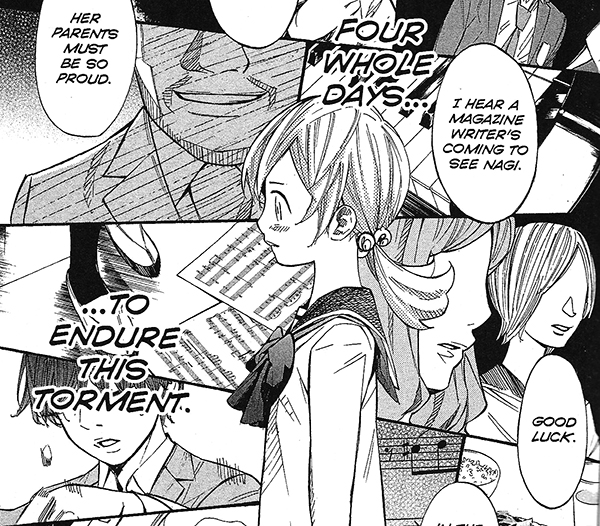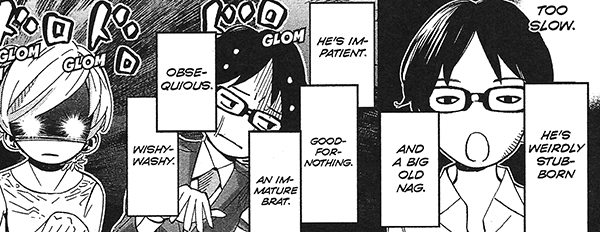 ”I hate Kosei Arima. But what I really hate is how wishy-washy and amateurish I am.”
”I hate Kosei Arima. But what I really hate is how wishy-washy and amateurish I am.”
Creative Staff:
Story and Art: Naoshi Arakawa
Translation: Alethea and Athena Nibley
Lettering: Paige Pumphrey
Editing: Paul Starr
What They Say:
COMBINED FORCES
“Want to commit double suicide with me?” Kaori’s words echo in Kosei’s mind. What can he do for her now, while she is still hospitalized? At the Aiza home, Nagi sees her brother Takeshi fall deeper and deeper into a slump and wonders how to cheer him up. Amid their worries, the teacher and student form a surprise duo for Kurumigaoka Middle School’s festival. What will happen with two pianists on one piano?!
The Review:
Content: (please note that content portions of a review may contain spoilers)
What I didn’t like about Nagi’s character in volume 8 of Your Lie in April was that her character establishment was such an obvious deviation from what you’d consider the main focus of the story. Up until this point, author Arakawa told the story of the handful of children serious enough in their musical studies to want to pursue it as a career—mental breakdowns and all. So to move from that level of obsession to the lite equivalent of it just felt incredibly filler-ish.
Thankfully, this volume makes me forgiving of all that.
While the majority focus of volume 9 is still on Nagi Aiza, Arakawa actually makes a point of fleshing out her character to be more than the cute face claiming to secretly want revenge on Kosei for her older brother’s sake. From the get-go, we know that her intentions when playing the piano aren’t all that pure, wanting to get her brother out of his musical slump. But it’s in this lack of nobility that we’re able to see her character grow. And while she may not have plans to go pro any time soon, it’s that casual attitude that makes her all the more relatable.
Unlike Kosei who we’re introduced to well after his mental breakdown, we see the outside pressures of Nagi as they unfold. Not even a pro yet, she’s already exposed to pressures not only to put on a good performance for the sake of her school, but hatred and jealousy from the community as well, claiming her cute demeanor are what give her such opportunities in the first place. It’s this unrelenting onslaught of outside pressures and reactions to them that really drive home Nagi’s character. And while the anime adaptation covered her arc similarly, author Arakawa gives it a special amount of attention that honestly feels better executed. The pressures aren’t treated in comparison to Kosei’s, but rather a separate beast altogether attacking someone wholly unfamiliar with them in the first place.
If anything, comparisons to Kosei don’t come up until around halfway through this volume, when you see Hiroko witness Nagi as she begins to actually succumb to those outside pressures. Having seen Kosei’s own breakdown, Hiroko is more wary of the situation and is willing to do anything she can to prevent what happened to Kosei to happen to another musician. Furthermore, during her actual performance with Kosei, you begin to see a role-reversal of sorts. While earlier volumes pit Kaori as a driving factor that pushed Kosei to achieve new heights musically, it’s Kosei this time that pushes Nagi forward—his intentionally strong accompanying performance outshining Nagi to the point that Nagi has no other choice but to react with an even stronger performance. Even the thought process Nagi has while playing is similar to Kosei’s own when he thinks about how pushy and stern Kaori is. It’s a nice change of roles as we see Kosei take the reigns as a teacher, also reflecting how his relationship with music as a whole has been adapting and changing thanks to those he interacts with.
In Summary:
While we’ve stepped away from the melodrama that is love triangles and major performances, Your Lie in April volume 9 makes the slight sidetracking worthwhile. It’s the kind of volume that stands decently well on its own, covering the majority of Nagi Aiza’s musical journey under the tutelage of Kosei. And while her character arc is essentially a less traumatic version of Kosei’s, the more subdued nature of it makes it all the more relatable and feels noticeably more meaningful than the anime’s adaptation of it.
Content Grade: A
Art Grade: A
Packaging Grade: A
Text/Translation Grade: A
Age Rating: 13+
Released By: Kodansha Comics
Release Date: August 30, 2016
MSRP: $10.99





